

Compact Muon Solenoid
LHC, CERN
| CMS-HIG-17-009 ; CERN-EP-2018-127 | ||
| Search for resonant pair production of Higgs bosons decaying to bottom quark-antiquark pairs in proton-proton collisions at 13 TeV | ||
| CMS Collaboration | ||
| 10 June 2018 | ||
| JHEP 08 (2018) 152 | ||
| Abstract: A search for a narrow-width resonance decaying into two Higgs bosons, each decaying into a bottom quark-antiquark pair, is presented. The search is performed using proton-proton collision data corresponding to an integrated luminosity of 35.9 fb$^{-1}$ at $\sqrt{s} = $ 13 TeV recorded by the CMS detector at the LHC. No evidence for such a signal is observed. Upper limits are set on the product of the production cross section for the resonance and the branching fraction for the selected decay mode in the resonance mass range from 260 to 1200 GeV. | ||
| Links: e-print arXiv:1806.03548 [hep-ex] (PDF) ; CDS record ; inSPIRE record ; HepData record ; CADI line (restricted) ; | ||
| Figures | |

png pdf |
Figure 1:
The selection efficiency for simulated ${\mathrm {X}\to {\mathrm {H}} ({{\mathrm {b}} {\overline {\mathrm {b}}}}) {\mathrm {H}} ({{\mathrm {b}} {\overline {\mathrm {b}}}})}$ events for a spin-0 radion (left) and a spin-2 bulk KK-graviton (right), at different stages of the event selection for each mass hypothesis, for the low-mass region (solid) and the medium-mass region (dashed). The vertical line at 580 GeV corresponds to the transition between the two selections. |

png pdf |
Figure 1-a:
The selection efficiency for simulated ${\mathrm {X}\to {\mathrm {H}} ({{\mathrm {b}} {\overline {\mathrm {b}}}}) {\mathrm {H}} ({{\mathrm {b}} {\overline {\mathrm {b}}}})}$ events for a spin-0 radion, at different stages of the event selection for each mass hypothesis, for the low-mass region (solid) and the medium-mass region (dashed). The vertical line at 580 GeV corresponds to the transition between the two selections. |
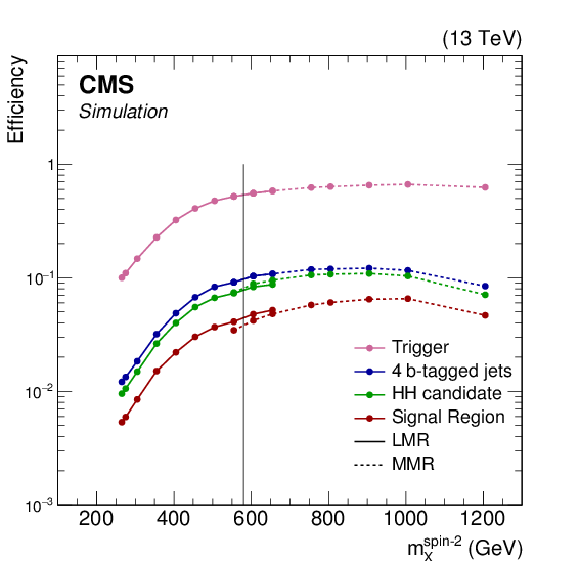
png pdf |
Figure 1-b:
The selection efficiency for simulated ${\mathrm {X}\to {\mathrm {H}} ({{\mathrm {b}} {\overline {\mathrm {b}}}}) {\mathrm {H}} ({{\mathrm {b}} {\overline {\mathrm {b}}}})}$ events for a spin-2 bulk KK-graviton, at different stages of the event selection for each mass hypothesis, for the low-mass region (solid) and the medium-mass region (dashed). The vertical line at 580 GeV corresponds to the transition between the two selections. |
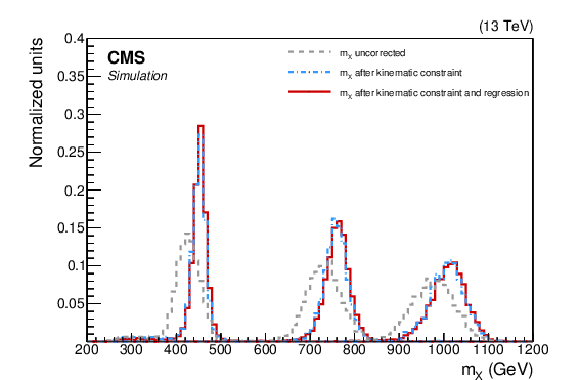
png pdf |
Figure 2:
The $m_{\mathrm {X}}$ distribution for simulated signal events (spin-2 bulk KK-graviton) after the event selection criteria for the 450, 750, and 1000 GeV mass hypotheses, with and without the correction obtained by constraining $m_{{\mathrm {H}}}$ (kinematic constraint) and the specific b jet energy corrections (regression). The distributions are normalized so that the area under the curve for each mass is the same |
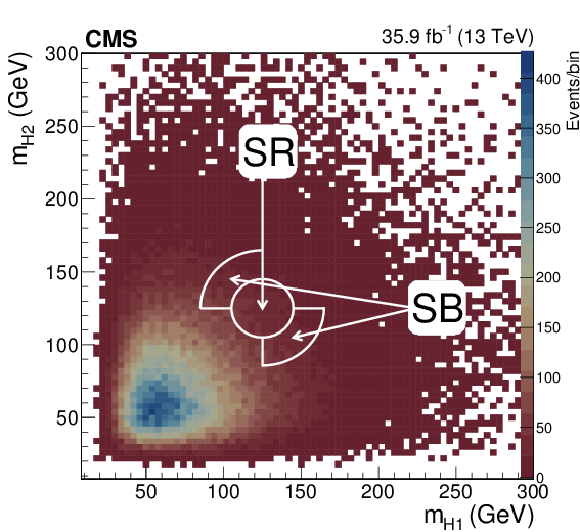
png pdf |
Figure 3:
Definition of the SR and the SB in the ($m_{{\mathrm {H}} _1}$, $m_{{\mathrm {H}} _2}$) plane used to motivate and validate the parametric model for the multijet background. The quantities $m_{{\mathrm {H}} _1}$ and $m_{{\mathrm {H}} _2}$ are the two reconstructed Higgs boson masses after applying the multivariate regression described in Section 4. Data corresponds to a selection in the MMR. |

png pdf |
Figure 4:
The predicted $m_{\mathrm {X}}$ distribution in data for the LMR (square) and the actual distribution in the SR (circle) defined centered at a Higgs boson mass of 150 GeV. |

png pdf |
Figure 5:
The $m_{\mathrm {X}}$ distribution in the SB of the MMR and the fit to the background multijet shape are shown. The shaded regions correspond to variations of $\pm $1 and $\pm $2 standard deviation (s.d.) in this parametrized form. Here $n$ is the number of degrees of freedom in each fit. The lower panel shows the difference between the data and the fits, divided by the uncertainty in the number of data events. |

png pdf |
Figure 6:
The $m_{\mathrm {X}}$ distributions for LMR1 (left) and LMR2 (right) in the SR. These distributions are fitted in the two ranges to the reference model. A fit to the background-only hypothesis, multijets, is shown. The shaded regions correspond to variations of $\pm $1 and $\pm $2 standard deviation (s.d.) in the parametrized form. Here $n$ is the number of degrees of freedom in each fit. The lower panels show the difference between the data and the fits, divided by the uncertainty in the number of data events. |

png pdf |
Figure 6-a:
The $m_{\mathrm {X}}$ distribution for LMR1 in the SR. These distributions are fitted in the two ranges to the reference model. A fit to the background-only hypothesis, multijets, is shown. The shaded regions correspond to variations of $\pm $1 and $\pm $2 standard deviation (s.d.) in the parametrized form. Here $n$ is the number of degrees of freedom in each fit. The lower panel shows the difference between the data and the fits, divided by the uncertainty in the number of data events. |
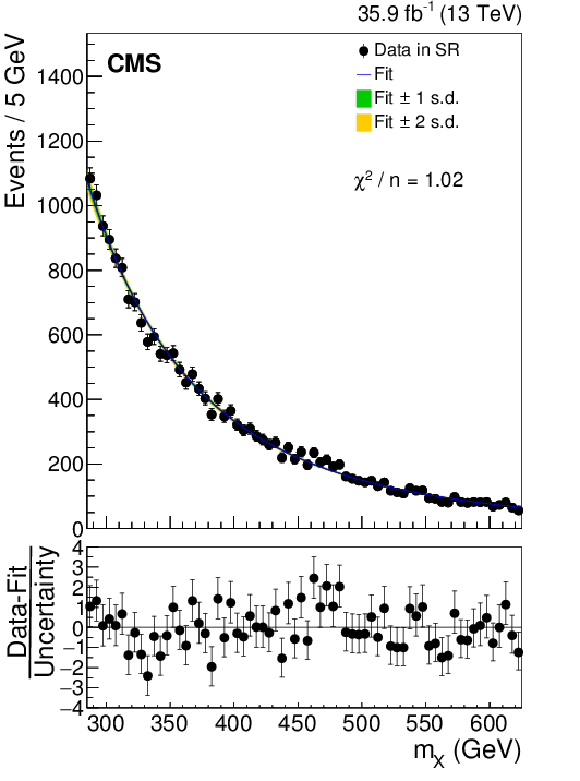
png pdf |
Figure 6-b:
The $m_{\mathrm {X}}$ distribution for LMR2 in the SR. These distributions are fitted in the two ranges to the reference model. A fit to the background-only hypothesis, multijets, is shown. The shaded regions correspond to variations of $\pm $1 and $\pm $2 standard deviation (s.d.) in the parametrized form. Here $n$ is the number of degrees of freedom in each fit. The lower panel shows the difference between the data and the fits, divided by the uncertainty in the number of data events. |
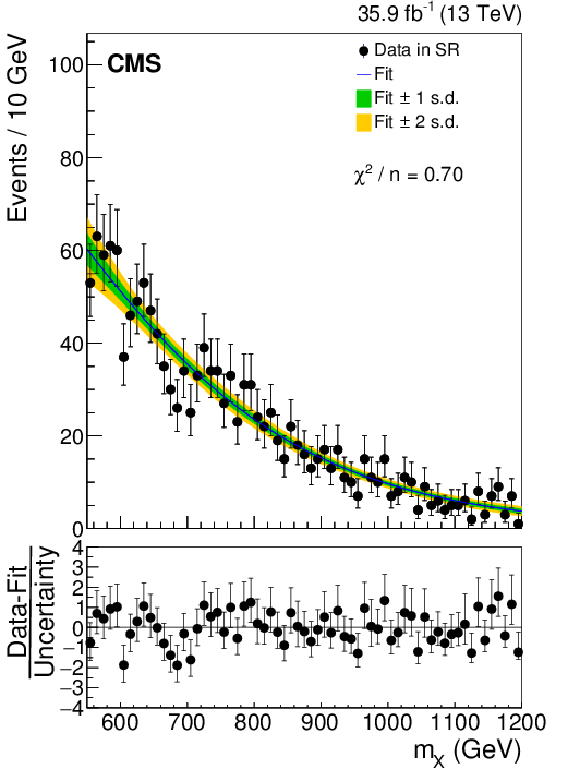
png pdf |
Figure 7:
The $m_{\mathrm {X}}$ distribution for the multijet background in the SR in data for the MMR. A fit to the background-only hypothesis, which consists of the multijet shape, is shown. The shaded regions correspond to variations of $\pm $1 and $\pm $2 standard deviation (s.d.) in this parametrized form. Here $n$ is the number of degrees of freedom in each fit. The lower panel shows the difference between the data and the fits, divided by the uncertainty in the number of data events. |
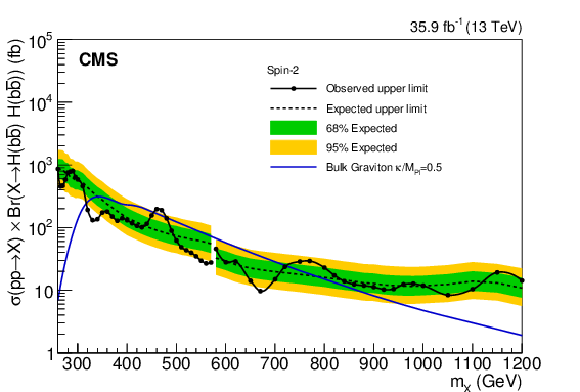
png pdf |
Figure 8:
The observed and expected upper limits on the cross section for a spin-2 resonance ${\mathrm {X}\to {\mathrm {H}} ({{\mathrm {b}} {\overline {\mathrm {b}}}}) {\mathrm {H}} ({{\mathrm {b}} {\overline {\mathrm {b}}}})}$ at 95% CL, using the asymptotic CLs method. The theoretical cross section for the bulk KK-graviton, with $\kappa / {{M_\mathrm {Pl}}} = $ 0.5, $\kappa l = $ 35, decaying to four b jets via Higgs bosons is overlaid. The transition between the LMR and the MMR is based on the expected sensitivity, resulting in the observed discontinuity. |

png pdf |
Figure 9:
The observed and expected upper limits on the cross section for a spin-0 resonance ${\mathrm {X}\to {\mathrm {H}} ({{\mathrm {b}} {\overline {\mathrm {b}}}}) {\mathrm {H}} ({{\mathrm {b}} {\overline {\mathrm {b}}}})}$ at 95% CL, using the asymptotic CLs method. The theoretical cross section for the production of a radion, with $\Lambda = $ 3 TeV, $\kappa l= $ 35, and no radion-Higgs boson mixing, decaying to four b jets via Higgs bosons is overlaid. The transition between the LMR and the MMR is based on the expected sensitivity, resulting in the observed discontinuity. |
| Tables | |

png pdf |
Table 1:
Definitions of the control regions we used to test the functional form as described in the text. |

png pdf |
Table 2:
Impact of systematic uncertainties on the signal efficiencies in the LMR and the MMR. |
| Summary |
| A search for a narrow-width resonance decaying into two Higgs bosons, each decaying into a bottom quark-antiquark pair, is presented. The search is performed using proton-proton collision data corresponding to an integrated luminosity of 35.9 fb$^{-1}$ at $\sqrt{s} = $ 13 TeV recorded by the CMS detector at the LHC. No evidence for a signal is observed and upper limits at 95% confidence level on the production cross section for such spin-0 and spin-2 resonances, in the mass range from 260 to 1200 GeV, are set. In particular, a bulk KK-graviton (with $\kappa l$ = 35, $\kappa = 0.5\,{{M_\mathrm{Pl}}}$) in the mass range 320-450 GeV and 480-720 GeV, and a radion (with decay constant $\Lambda = $ 3 TeV) in the mass range 260-280 GeV, 300-450 GeV and 480-1120 GeV are excluded at a 95% confidence level. This analysis outperforms a similar search by CMS using 17.9 fb$^{-1}$ collected at 8 TeV [15] and extends the sensitivity to the gluon fusion production of a radion with decay constant $\Lambda = $ 3 TeV and to bulk graviton with $\kappa$ set to $0.5\, {{M_\mathrm{Pl}}}$. |
| References | ||||
| 1 | ATLAS Collaboration | Observation of a new particle in the search for the standard model Higgs boson with the ATLAS detector at the LHC | PLB 716 (2012) 1 | 1207.7214 |
| 2 | CMS Collaboration | Observation of a new boson at a mass of 125 GeV with the CMS experiment at the LHC | PLB 716 (2012) 30 | CMS-HIG-12-028 1207.7235 |
| 3 | CMS Collaboration | Observation of a new boson with mass near 125 GeV in pp collisions at $ \sqrt{s} = $ 7 and 8 TeV | JHEP 06 (2013) 081 | CMS-HIG-12-036 1303.4571 |
| 4 | ATLAS and CMS Collaborations | Combined measurement of the Higgs boson mass in $ pp $ collisions at $ \sqrt{s}= $ 7 and 8 TeV with the ATLAS and CMS experiments | PRL 114 (2015) 191803 | 1503.07589 |
| 5 | CMS Collaboration | Measurements of properties of the Higgs boson decaying into the four-lepton final state in pp collisions at $ \sqrt{s}= $ 13 TeV | JHEP 11 (2017) 047 | CMS-HIG-16-041 1706.09936 |
| 6 | L. Randall and R. Sundrum | Large mass hierarchy from a small extra dimension | PRL 83 (1999) 3370 | hep-ph/9905221 |
| 7 | W. D. Goldberger and M. B. Wise | Modulus stabilization with bulk fields | PRL 83 (1999) 4922 | hep-ph/9907447 |
| 8 | O. DeWolfe, D. Z. Freedman, S. S. Gubser, and A. Karch | Modeling the fifth dimension with scalars and gravity | PRD 62 (2000) 046008 | hep-th/9909134 |
| 9 | C. Cs\'aki, M. Graesser, L. Randall, and J. Terning | Cosmology of brane models with radion stabilization | PRD 62 (2000) 045015 | hep-ph/9911406 |
| 10 | H. Davoudiasl, J. L. Hewett, and T. G. Rizzo | Phenomenology of the Randall-Sundrum gauge hierarchy model | PRL 84 (2000) 2080 | hep-ph/9909255 |
| 11 | C. Cs\'aki, M. L. Graesser, and G. D. Kribs | Radion dynamics and electroweak physics | PRD 63 (2001) 065002 | hep-th/0008151 |
| 12 | K. Agashe, H. Davoudiasl, G. Perez, and A. Soni | Warped gravitons at the LHC and beyond | PRD 76 (2007) 036006 | hep-ph/0701186 |
| 13 | G. F. Giudice, R. Rattazzi, and J. D. Wells | Graviscalars from higher dimensional metrics and curvature Higgs mixing | NPB 595 (2001) 250 | hep-ph/0002178 |
| 14 | A. Oliveira | Gravity particles from warped extra dimensions, predictions for LHC | 1404.0102 | |
| 15 | CMS Collaboration | Search for resonant pair production of Higgs bosons decaying to two bottom quark-antiquark pairs in proton-proton collisions at 8 TeV | PLB 749 (2015) 560 | CMS-HIG-14-013 1503.04114 |
| 16 | ATLAS Collaboration | Search for Higgs boson pair production in the $ \mathrm{b\bar{b}}\mathrm{b\bar{b}} $ final state from pp collisions at $ \sqrt{s} = $ 8 TeV with the ATLAS detector | EPJC 75 (2015) 412 | 1506.00285 |
| 17 | ATLAS Collaboration | Search for pair production of Higgs bosons in the $ \mathrm{b\bar{b}}\mathrm{b\bar{b}} $ final state using proton--proton collisions at $ \sqrt{s} = $ 13 TeV with the ATLAS detector | PRD 94 (2016) 052002 | 1606.04782 |
| 18 | CMS Collaboration | Search for Higgs boson pair production in events with two bottom quarks and two tau leptons in proton-proton collisions at $ \sqrt{s} = $ 13 TeV | PLB 778 (2018) 101 | CMS-HIG-17-002 1707.02909 |
| 19 | CMS Collaboration | Search for two Higgs bosons in final states containing two photons and two bottom quarks in proton-proton collisions at 8 TeV | PRD 94 (2016) 052012 | CMS-HIG-13-032 1603.06896 |
| 20 | ATLAS Collaboration | Search for Higgs boson pair production in the $ \gamma\gamma \mathrm{b\bar{b}} $ final state using $ {\mathrm{p}}{\mathrm{p}} $ collision data at $ \sqrt{s}= $ 8 TeV from the ATLAS detector | PRL 114 (2015) 081802 | 1406.5053 |
| 21 | ATLAS Collaboration | Searches for Higgs boson pair production in the $ hh\to \mathrm{b\bar{b}}\tau\tau, \gamma\gamma WW^*, \gamma\gamma \mathrm{b\bar{b}}, \mathrm{b\bar{b}}\mathrm{b\bar{b}} $ channels with the ATLAS detector | PRD 92 (2015) 092004 | 1509.04670 |
| 22 | CMS Collaboration | Search for resonant and nonresonant Higgs boson pair production in the $ \mathrm{b\bar{b}} l\nu l\nu $ final state in proton-proton collisions at $ \sqrt{s} = $ 13 TeV | JHEP 01 (2018) 054 | CMS-HIG-17-006 1708.04188 |
| 23 | CMS Collaboration | The CMS experiment at the CERN LHC | JINST 3 (2008) S08004 | CMS-00-001 |
| 24 | GEANT4 Collaboration | GEANT4 --- a simulation toolkit | NIMA 506 (2003) 250 | |
| 25 | M. Gouzevitch et al. | Scale-invariant resonance tagging in multijet events and new physics in Higgs pair production | JHEP 07 (2013) 148 | 1303.6636 |
| 26 | J. Alwall et al. | The automated computation of tree-level and next-to-leading order differential cross sections, and their matching to parton shower simulations | JHEP 07 (2014) 079 | 1405.0301 |
| 27 | NNPDF Collaboration | Parton distributions for the LHC Run II | JHEP 04 (2015) 040 | 1410.8849 |
| 28 | T. Sjostrand et al. | An Introduction to PYTHIA 8.2 | CPC 191 (2015) 159 | 1410.3012 |
| 29 | CMS Collaboration | Particle-flow reconstruction and global event description with the CMS detector | JINST 12 (2017) P10003 | CMS-PRF-14-001 1706.04965 |
| 30 | M. Cacciari, G. P. Salam, and G. Soyez | The Anti-$ {k_{\mathrm{T}}} $ jet clustering algorithm | JHEP 04 (2008) 063 | 0802.1189 |
| 31 | M. Cacciari, G. P. Salam, and G. Soyez | FastJet User Manual | EPJC 72 (2012) 1896 | 1111.6097 |
| 32 | M. Cacciari and G. P. Salam | Dispelling the $ N^{3} $ myth for the $ k_t $ jet-finder | PLB 641 (2006) 57 | hep-ph/0512210 |
| 33 | M. Cacciari and G. P. Salam | Pileup subtraction using jet areas | PLB 659 (2008) 119 | 0707.1378 |
| 34 | CMS Collaboration | Jet energy scale and resolution in the CMS experiment in pp collisions at 8 TeV | JINST 12 (2017) P02014 | CMS-JME-13-004 1607.03663 |
| 35 | CMS Collaboration | Identification of heavy-flavour jets with the CMS detector in pp collisions at 13 TeV | JINST 13 (2018) P05011 | CMS-BTV-16-002 1712.07158 |
| 36 | D. Guest et al. | Jet flavor classification in high-energy physics with deep neural networks | PRD 94 (2016) 112002 | 1607.08633 |
| 37 | CMS Collaboration | Identification of b-quark jets with the CMS experiment | JINST 8 (2013) P04013 | CMS-BTV-12-001 1211.4462 |
| 38 | CMS Collaboration | Search for a massive resonance decaying to a pair of Higgs bosons in the four b quark final state in proton-proton collisions at $ \sqrt{s}= $ 13 TeV | PLB 781 (2018) 244 | 1710.04960 |
| 39 | CMS Collaboration | Search for the standard model Higgs boson produced in association with a W or a Z boson and decaying to bottom quarks | PRD 89 (2014) 012003 | CMS-HIG-13-012 1310.3687 |
| 40 | CMS Collaboration | Search for the standard model Higgs boson produced through vector boson fusion and decaying to $ b \overline{b} $ | PRD 92 (2015) 032008 | CMS-HIG-14-004 1506.01010 |
| 41 | CMS Collaboration | Determination of jet energy calibration and transverse momentum resolution in CMS | JINST 6 (2011) 11002 | CMS-JME-10-011 1107.4277 |
| 42 | H. Voss, A. Hocker, J. Stelzer, and F. Tegenfeldt | TMVA, the toolkit for multivariate data analysis with ROOT | in XIth International Workshop on Advanced Computing and Analysis Techniques in Physics Research (ACAT), p. 40 2007 | physics/0703039 |
| 43 | Belle Collaboration | A detailed test of the CsI(Tl) calorimeter for BELLE with photon beams of energy between 20-MeV and 5.4-GeV | NIMA 441 (2000) 401 | |
| 44 | M. J. Oreglia | A study of the reactions $\psi' \to \gamma\gamma \psi$ | PhD thesis, Stanford University, 1980 SLAC Report SLAC-R-236, see A | |
| 45 | CMS Collaboration | CMS luminosity measurements for the 2016 data taking period | CMS-PAS-LUM-17-001 | CMS-PAS-LUM-17-001 |
| 46 | J. Butterworth et al. | PDF4LHC recommendations for LHC Run II | JPG 43 (2016) 023001 | 1510.03865 |
| 47 | G. Cowan, K. Cranmer, E. Gross, and O. Vitells | Asymptotic formulae for likelihood-based tests of new physics | EPJC 71 (2011) 1554 | 1007.1727 |
| 48 | T. Junk | Confidence level computation for combining searches with small statistics | NIMA 434 (1999) 435 | hep-ex/9902006 |
| 49 | A. L. Read | Presentation of search results: the CL$ _s $ technique | JPG 28 (2002) 2693 | |
| 50 | The ATLAS Collaboration, The CMS Collaboration, The LHC Higgs Combination Group | Procedure for the LHC Higgs boson search combination in Summer 2011 | CMS-NOTE-2011-005 | |

|
Compact Muon Solenoid LHC, CERN |

|

|

|

|

|

|